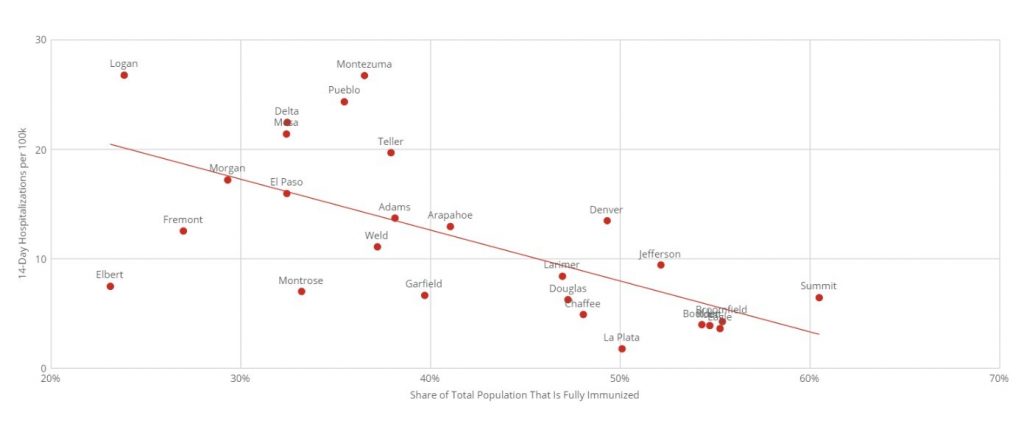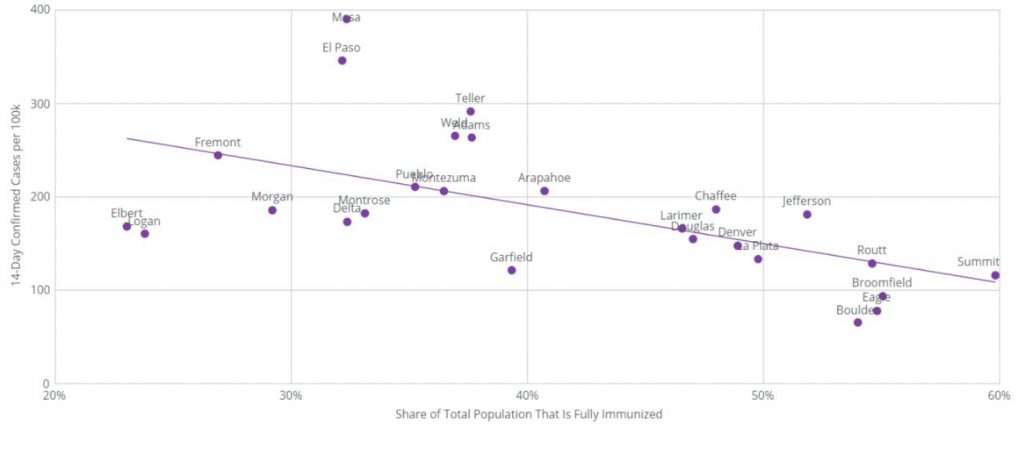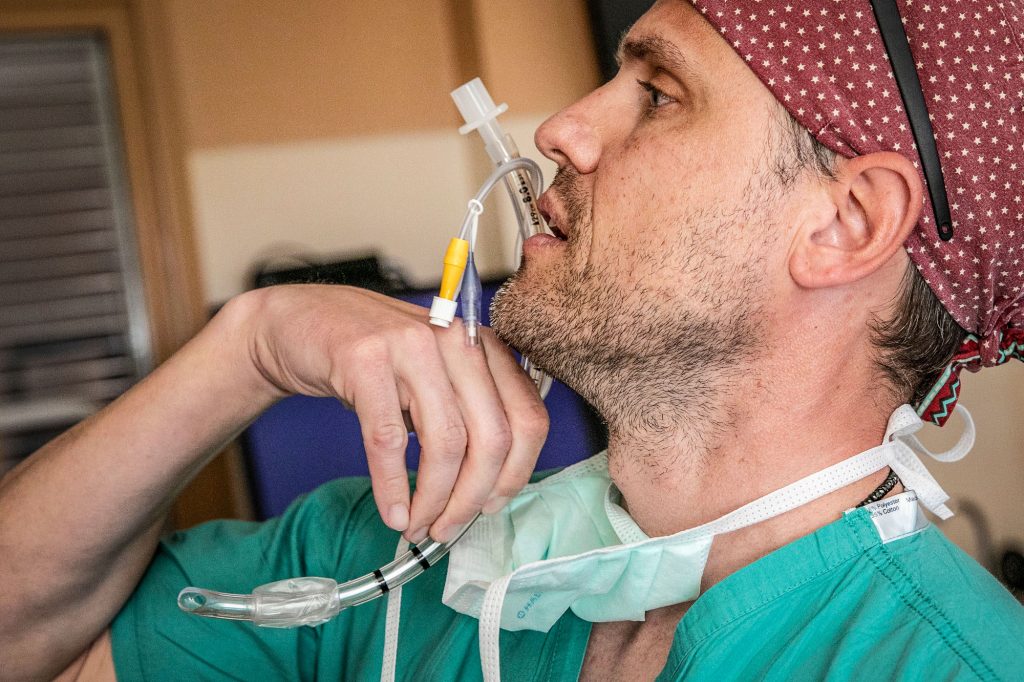
Even as the pandemic seems to be receding, about 500 people remain hospitalized in Colorado with COVID-19. Almost all of them share a common trait: they are unvaccinated.
The vaccines now in use and available to just about anyone 12 and older provide near universal protection against illness and even greater protection against severe cases leading to hospitalizations. Even more, doctors in hospitals treating COVID-19 patients in the state can’t recall a single death of a vaccinated person.
But after a year of relentless work, the constant churn of unvaccinated patients continues to wear down the doctors and nurses keeping them alive, or falling short and seeing them die.

“We are tired," said Dr. Sandeep Vijan of Parkview Medical Center in Pueblo. "We've been doing this for a year. We are emotionally tired, tired of seeing people die. We are physically tired.”
The frustration for some partly results from the knowledge that at least some of the cases may have been avoidable.
“We've taken a deep look at this,” said Dr. JP Valin, chief clinical officer at SCL Health. “Ninety-five percent of the patients who have been hospitalized since February are unvaccinated.”
And they are skewing younger.
“A lot of the patients that we're seeing now are young, thirties to forties and can be critically ill,” said Dr. Steve Brizendine, the chief of the medical staff at Platte Valley Medical Center in Brighton.
Statistics bear that out.
Hospitalization numbers show the virus spreading rapidly among the unvaccinated.
In the week of May 23, almost 19 percent of hospitalized patients were between the ages of newborn and 39. That’s up from Nov. 22 when that age group made up just 12 percent of the patient caseload.
Patients 60 to 79 years old still make up the largest portion of those hospitalized, but at 42.64 percent of the patients in the week of May 23, that’s a decrease from 45.38 percent of the COVID beds that were occupied by that age group in November.
The Washington Post recently analyzed state-by-state data. It found the virus is still spreading as fast among the unvaccinated as it did during last winter’s surge. Colorado is one of a few states with case spikes among the unvaccinated at rates double the national figure. But Valin said the flip side of that is that, for those getting them, vaccines are doing their job.
“The good news is that those handful of patients that we have admitted to the hospital that have been vaccinated, we've seen no deaths in that group,” said Valin. “And actually virtually all of them have been discharged home or back out to a skilled nursing facility for post-acute care afterwards.”
Hispanic and Black residents continue to be hospitalized at disproportionately high rates, according to data on the state’s dashboard. Hispanics make up about 20 percent of the state population, but in recent weeks make up roughly 28 percent of those hospitalized; Black Coloradans account for nearly 4 percent of the state’s population, but have been hospitalized in recent weeks at double that figure.
Maggie Gomez who chairs the state’s Health Equity Commission said underlying obstacles often prevent access or delay people getting healthcare, including vaccinations. Those include housing and employment issues as well as “transportation or geography or immigration status or language barriers or all of those social determinants of health, right?”
And she said despite efforts from the state health department, community groups, churches and others vaccination rates are still lagging behind in communities of color, especially with Hispanics. “I really appreciate the commercials and they're doing stuff in Spanish and folks that, you know, are not just white and that's all really good and super important,” Gomez said. “It’s not really reaching the folks that it needs to reach though.”
Another data point: men are less likely to be vaccinated so far in Colorado (47.1% for men versus 52.6% for women) and more likely to get hospitalized with COVID-19 than women (52.4% for men versus 47.5% for women).
Other data clearly show the impact of the vaccines. The state health department plotted both COVID-19 cases and hospitalizations with vaccinations county by county and shared that data with local health officials. Dr. Rachel Herlihy, the state epidemiologist, said counties and communities with the highest vaccination rates are seeing the lowest spread of the virus, and vice versa. “Those groups where the vaccination rates are lower, are going to be the groups where the risk of transmission continues to be high,” said Herlihy.

The charts clearly show a group of Denver area and mountain counties with higher vaccination rates seeing fewer cases and hospitalizations. But counties like El Paso, Pueblo, Weld and Mesa have recorded fewer vaccinations per capita and hence more people are still getting sick and hospitalized due to the virus.
That means Colorado will likely see a very spotty, uneven pandemic in the months ahead, where trouble keeps popping up among the unvaccinated.

“There are always going to be these pockets of under-vaccination,” said Herlihy. “And those are going to continue to be the communities that are most at risk, whether that's a county, a town, a school, a playgroup, whatever it might be.”
That’s why local public health authorities are working hard to increase vaccination rates.
“There's definitely a strong correlation, especially with just the number of infected individuals. That's why right now my push is on getting people vaccinated.” said Jeff Kuhr, executive director of Mesa County Public Health. He said in the coming weeks the county is planning cash drawings for those who have been vaccinated, like the state recently announced.
Mesa County is seeing some worrisome virus trends, like the arrival of more transmissible variants, including one first found in India. Vaccines so far appear effective against variants, but Kuhr said a girl older than 10 who recently died tested positive for the India variant.
“We’ve had quite an increase (in cases). I feel like we're stable right now, but I can't say that we're limiting spread. We're seeing a lot more cases in children, like the state. We have a lot more of (the) variant strains.”
Kuhr said the girl got hospitalized before the Pfizer vaccine was authorized for 12 to 15, so was not eligible for vaccination.
He said most deaths and hospitalizations in the county are among the unvaccinated. Many are adults who have been able to get their shots for weeks. Some are waiting, some have questions. And, Kuhr said, some still have doubts about the severity of COVID-19.
“So, it's sort of ‘my chances of getting a severe case is low.’ There's a lot of misinformation about the vaccine,” he said. “‘I would rather take the chance of getting a mild case of COVID than getting a complication from the vaccine.’”
At Platte Valley Medical Center, nurse Dianna Read said her husband was hospitalized and on a ventilator for two weeks with COVID-19 last year. She said unfortunately many folks won’t take it seriously unless it hits close to home.
“So seeing my husband go through that,” she said, “you can talk about going through those experiences, but unfortunately, a lot of people, unless they go through it, they just don't see or feel or realize how serious it really is.”
Brizendine said in some cases patients are convinced they don’t have COVID-19. He recalled one who yelled at, chastised and belittled staff who were wearing masks and doing their best to care for him, saying “there’s no such thing as COVID,” only to have a deathbed conversion.

“All of us here, working on the frontline, taking care of these patients that are critically ill, saving them, some of them dying, and for people to feel that this is not a true virus, this is not a true pandemic, was highly disappointing, highly disappointing, discouraging,” he said.
Brizendine said he anticipated the mental health impact of treating pandemic patients will last years — but he said providers are able to process their experience through a support group. And after being through the coronavirus battles together, an unspoken link is formed. “It just builds that bond. And then it's a better team,” of providers in the hospital. “It's a teamwork feeling that you can take care of that next patient even better.”
It’s been a long haul and frontline providers are ready for the crisis to be over, Brizendine said, something only widespread vaccination can bring.







